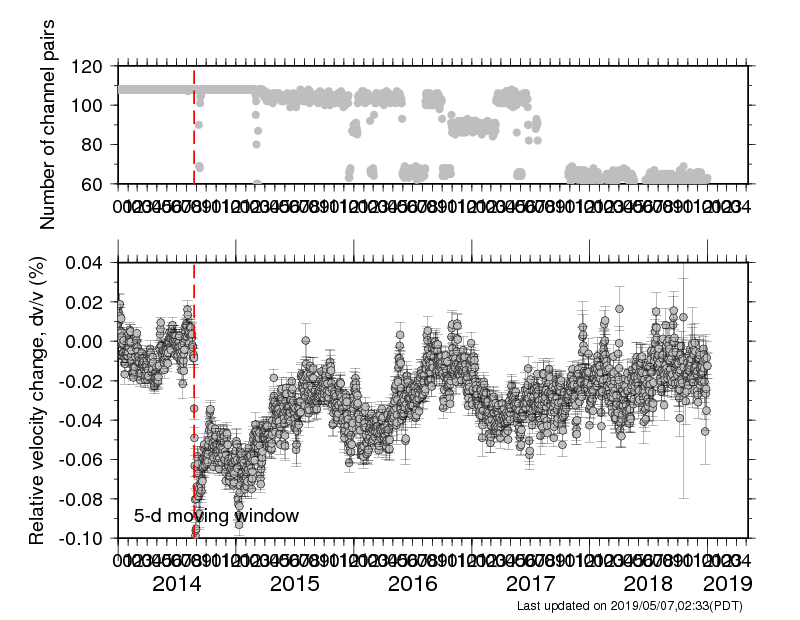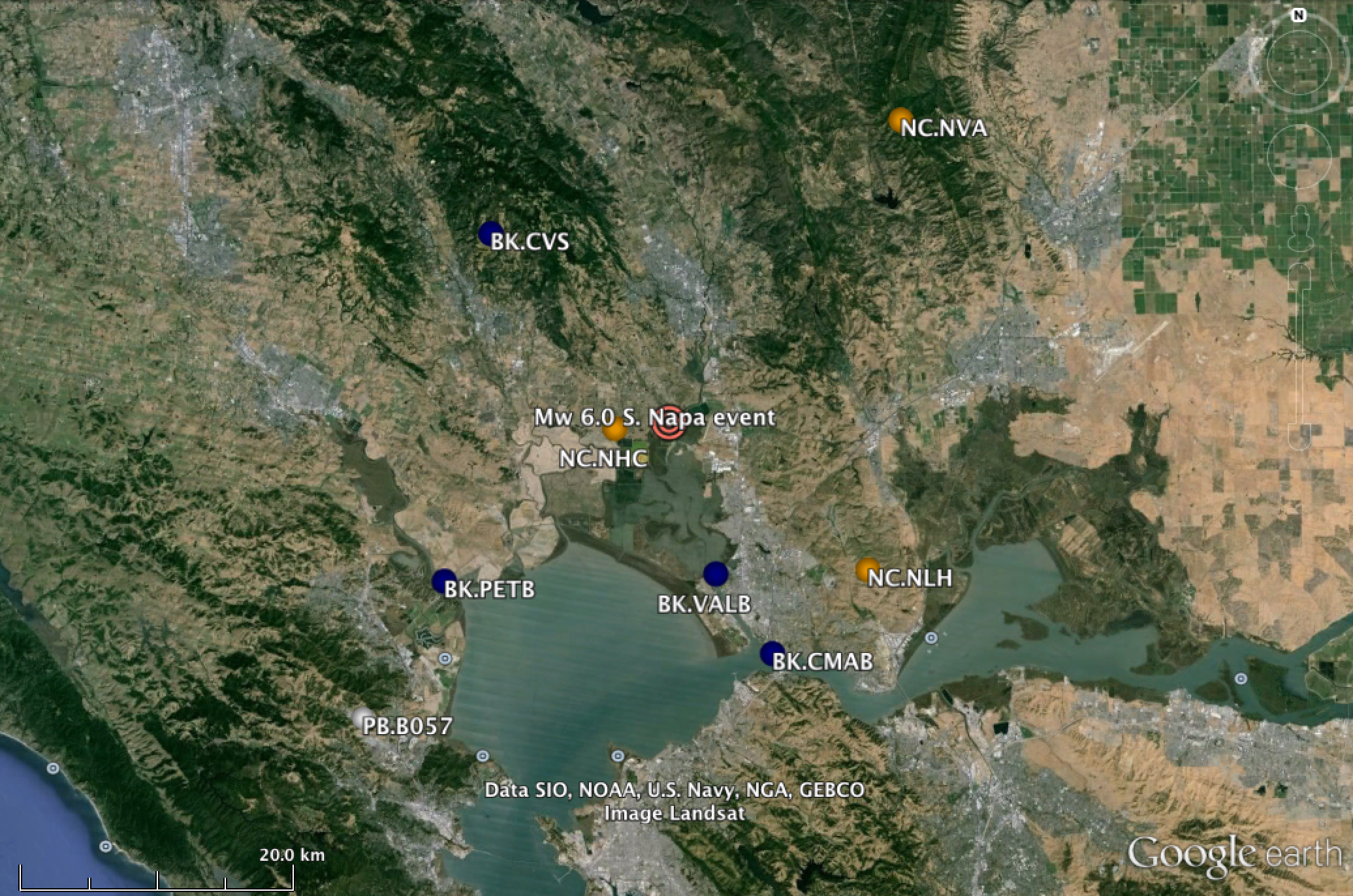Monitoring of Relative Velocity Change Following the 2014 Mw 6.0 South Napa Earthquake
We analyze ambient seismic noise wavefield to monitor temporal variations in seismic velocity associated with the 24 August 2014 Mw 6.0 South Napa earthquake.
Temporal Evolution in Seismic Velocity¶
We estimate relative velocity changes (dv/v) with MSNoise [Lecocq et al., 2014]. Our result is published at Geophysical Research Letters [Taira et al., 2015]. There are several arhived webpages showig the previous results: SNapa_Noise.09-16-14 (last updated on 09-16-14), SNapa_Noise.03-30-15 (last updated on 03-30-15), and SNapa_Noise.08-10-15 (last updated on 08-10-15).
Following Brenguier et al. [2008], our analysis focuses on waveforms in a frequency range of 0.1-0.9 Hz. A set of 8 stations are selected based on the high rate of data completeness. We determine the reference Green’s function (GF) for each station pair as the average of 1-day GFs obtained in the time interval, January 2013 through July 2014. The time history of dv/v is determined by measuring delay times between 5-day stacks of GFs and the reference GF.
We include horizontal component data for the dv/v measurement. The maximum available number of channel pairs (e.g., ZZ, ZN, ZE) is 108. We obtain about 0.08% velocity reduction following the South Napa earthquake (Figure 1). Note that dv/v is plotted at the end of the 5-day-length time window that is used for computing 5-day stacks of GFs. Threfore, dv/v values plotted within the first 4 days following the South Napa mainshock included the pre- and post-mainshock data and the gradual decay of dv/v in this period is an artifact.
To monitor the relative velocity change, we implement an automated system that updates the time history of dv/v shown in Figure 1. This automated process makes use of waveforms archived at the Northern California Earthquake Data Center [NCEDC, 2014]. Figure 1 is currently updated every day.
A minor difference between Figure 1 and the result from Taira et al. [2015] is about the reference GF. The automated system uses the reference GF from the data between January 2013 through July 2014. Taira et al. [2015] make use of the data between September 2010 through July 2014 for computing the reference GF. However, this does not change the resultant dv/v time seriese significantly.

Figure 1. Top panel shows the number of channel pairs used to infer the relative velocity change (dv/v). The bottom panel shows the time history of dv/v. The error bars represent the two-sigma standard deviation. The dashed red line indicates the origin time of the South Napa earthquake. Note that the dv/v values plotted within the first 4 days following the South Napa mainshock included the pre- and post-mainshock data and the gradual decay of dv/v in this period is an artifact.
Map View¶

Figure 2. Map view of stations and the South Napa earthquake. The 8 stations used is a combination of the Berkeley Digital Seismic Network & the Northern Hayward Fault Network operated by UC Berkeley, the Northern California Seismic Network operated by U.S. Geological Survey, and the EarthScope Plate Boundary Observatory operated by UNAVCO, Inc.
Acknowledgments
This work is partially support by the France-Berkeley Fund 2014-0051 and the National Science Foundation EAR-1053211. Waveform data, metadata, and earthquake catalog for this study were accessed through the Northern California Earthquake Data Center (NCEDC) [NCEDC, 2014].
References
Brenguier, F., M. Campillo, C. Hadziioannou, N. M. Shapiro, R. M. Nadeau, and E. Larose (2008), Postseismic relaxation along the San Andreas Fault at Parkfield from continuous seismological observations, Science, 321, doi:10.1126/science.1160943.
Lecocq T., C. Caudron, and F. Brenguier (2014), MSNoise, a Python Package for Monitoring Seismic Velocity Changes Using Ambient Seismic Noise, Seismological Research Letters, 85(3), 715‑726, doi:10.1785/0220130073.
NCEDC (2014), Northern California Earthquake Data Center, UC Berkeley Seismological Laboratory Dataset, doi:10.7932/NCEDC.
Taira, T., F. Brenguier, and Q. Kong (2015), Ambient noise based monitoring of seismic velocity changes associated with the 2014 Mw 6.0 South Napa earthquake, Geophys. Res. Lett., 42, doi:10.1002/2015GL065308. (Link to article)